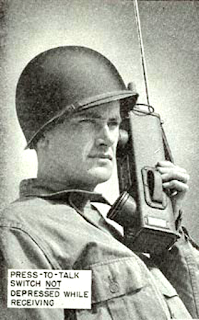 |
| SCR-536 Photo from Wikipedia |
The "walkie-talkie" that Max refers to was the SCR-536. The SCR-536 was not carried on the back as described by Max which makes me wonder if he had actually seen the radio Lean trained on. "The SCR-536 was developed for the U. S. Army in 1940 by Galvin Manufacturing (now Motorola) and in mass production in 1941. The SCR-536, which incorporated five vacuum tubes in a waterproof case, had no separate power switch. Instead the radio turned on when the antenna was pulled out, and off when it was retracted. The range of the unit varied with terrain; from a few hundred feet, to approximately one mile over land, and 3 miles over water."
- From Wikipedia




















